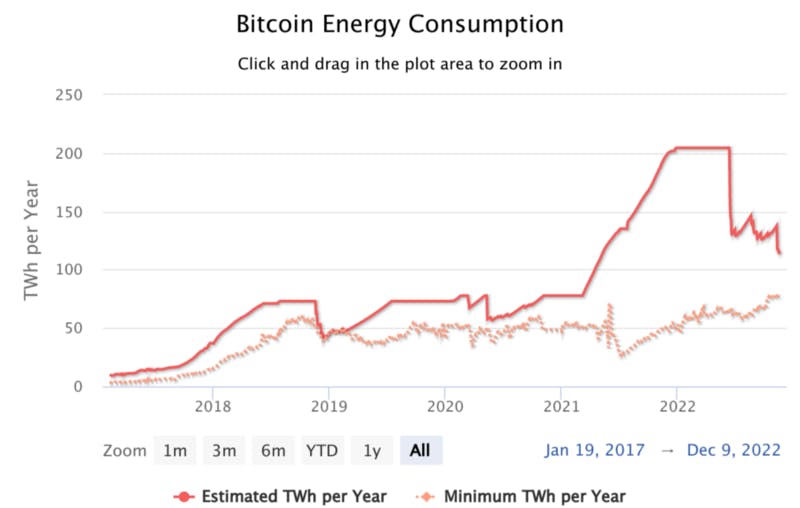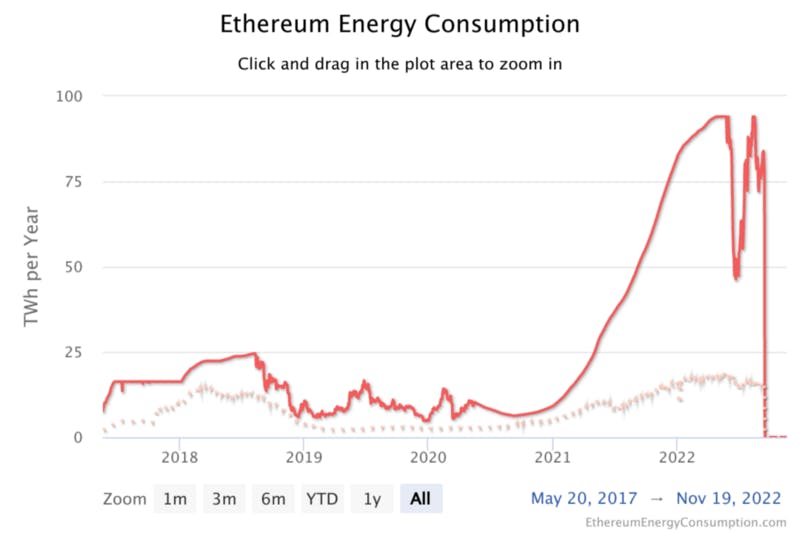Marketed as “1.6 million times more energy efficient” than Bitcoin, Cardano is undoubtedly a relatively energy-efficient cryptocurrency. This is due to Cardano’s use of a proof-of-stake (PoS) consensus mechanism instead of Bitcoin’s proof-of-work (PoW) consensus mechanism.
In a traditional PoW cryptocurrency, most of the energy is used in the first step of consensus: choosing someone to be in “charge” or be the block minter. Unlike PoS, PoW cryptocurrency miners mine hashes until a specific hash is found; the miner then becomes the block minter. Calculating these hashes can require a lot of computing power and energy. But how does Cardano quantitatively compare to other cryptocurrencies in terms of energy? Let us take a look.

Ouroboros is the proof-of-stake protocol for Cardano
Bitcoin

According to DIGICONOMIST, the Bitcoin blockchain (including miners), as of November 2022, uses around 116 TWh (terawatt hour) per year (read this article for an explanation of units of measure for electricity). To put that number in perspective: 1 TWh equals 1,000 GWh (gigawatt hour) and a typical nuclear power plant produces 8,000 GWh.
In late 2021 and early 2022, Bitcoin was at its highest level of energy consumption, consuming at a rate of about 204.5 TWh per year — this was probably due to high network usage/congestion.
Ethereum

The Ethereum blockchain is an especially useful blockchain to look at since it switched from a PoW to a PoS consensus mechanism in September 2022. At its height in 2022, the Ethereum PoW blockchain used around 94 TWh per year, which is about half of Bitcoin’s all-time high of 204.5 TWh per year.
However, after the merge (the switch from PoW to PoS) in September 2022, Ethereum energy consumption plummeted to about 0.01 TWh per year — a massive 99.989% drop.
Cardano

Cardano Energy Consumption (Red bars are the number of pools and the blue line is energy consumption)
According to Cexplorer.io, has been hovering around just under 3,000 staking pools and about 2.95 GWh. Compared to Bitcoin, this makes Cardano around 90,000 times more energy-efficient.
Cardano Carbon Footprint Projects
Like other “green” blockchains, Cardano has several climate and carbon-offset projects. Some of these include:
- Climate Neutral Cardano: An alliance of Cardano stake pools that donates a portion of their pool operator rewards to environmental projects. Here is a list of member staking pools.
- Cardano Carbon Footprint Catalyst Fund: This Catalyst Fund7 proposal aims to develop the first “independently verified Cardano Carbon Footprint Methodology” or, in other words, a “parametric model of Cardano’s climate impact.”
- Cardano Forest: This project by Veritree, the Cardano Foundation, and Climate Neutral Cardano aimed to plant 1 million trees. The project reached its funding goal in January 2022. As of November 2022, 35% of the mangrove trees have been planted in areas like Kenya, Indonesia, and Madagascar.
If you enjoyed reading this, consider following/clapping. It helps a lot!
Need help with crypto gas fees? Go here: reddit.com/r/CryptoGasFees
